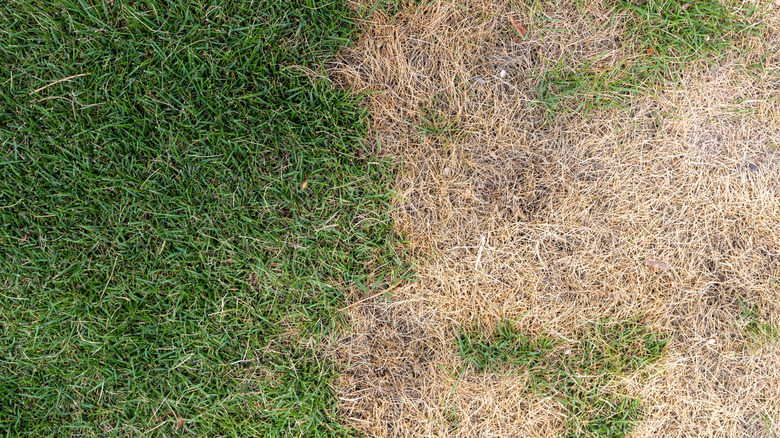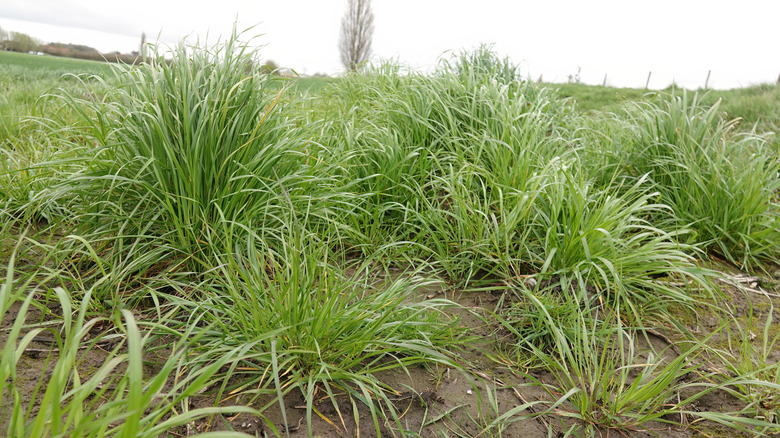Homeowner Concerned As Mysterious Lawn Growth Chokes Out Surrounding Grass: 'Not Good'
Not long ago, a homeowner posted a photo on Reddit of a perplexing lawn problem — clumps of growth, different from the rest of the turf grass, popping up and leaving a dead patch of the regular turf around it. The first commenter told the homeowner the phenomenon was clumping fescue, noting that situation was "not good." The clumping offender is called tall fescue (Lolium arundinaceum), and you could have it, too. You could see a clump that looks like grass, but not like the grass in the rest of the lawn — there might even be multiple clumps up to 2 feet wide and clumps merging into each other. Celebrated as a fall grass variety that makes a stunning lawn alternative, tall fescue can indeed look great when it comprises your entire lawn. The variety of tall fescue grown as turf grass has a narrower leaf and is known for its tolerance of heat, drought, and foot traffic. But, as House Digest garden expert Tiffany Selvey notes, "Tall fescue stands out in turf grass lawns because of its texture and growth habit. Tall fescue is also called clumping fescue because it shows up in large, dense clumps in the lawn, which spread quickly and can take over the space."
To be sure this clumping weed is tall fescue, examine the unwanted guest closely. Take a look at where the leaf meets the sheath for an obvious, pale-colored band at the leaf base. Grooved leaves also indicate you are looking at tall fescue. Tall fescue, a perennial, will likely have a coarser texture and a wider leaf blade than the rest of your turf grass. It grows vertically faster than other grasses and is considered a common blemish on turf grass lawns west of the Cascade mountains.
Tackle the challenge of removing tall fescue from your lawn
Among the different types of weeds that grow on a lawn, tall fescue in your lawn is one of the most challenging to control. "This weedy grass is woodier than more desirable grasses, and it's difficult to eradicate," Selvey affirms. Mowing it is a temporary solution at best, and the clumps are difficult to pass over. Mowing also reveals one of tall fescue's unattractive qualities — jagged edges on mowed leaf blades. Because of tall fescue's clumps, digging or cutting it out (try a sod cutter) is a little easier than it would be otherwise. You'll need to remove the entire plant and its roots, as root segments will grow back into new plants.
Herbicides are an option but problematic because they don't target tall fescue specifically and may also kill surrounding turf grass; apply only to the tall fescue clumps. Significant infestations may require a nonselective herbicide like glyphosate, but consider safer store-bought weed killer alternatives. Follow all label instructions for the herbicide you choose. Herbicide is best applied before the first frost in the fall. It can take up to two weeks to work, and a second application may be necessary. Some homeowners have had success using a combination of manual removal and herbicide treatment. Remove as much as you can by digging or cutting and apply herbicide to any remaining parts of the clumps. Once you've removed the clumps of tall fescue, you can reseed with your desired turf grass or put down sod. Consider building up your lawn to be a better competitor with tall fescue through practices like fertilization, watering, and increasing mowing height to 3 1/2 inches. Stay vigilant so you can spot any new tall fescue that pays a visit.

